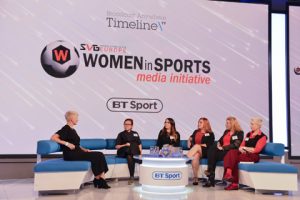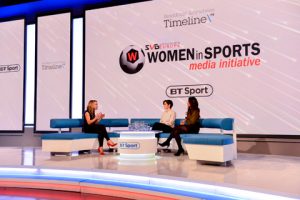International Women’s Day: The future for sports broadcast is female
While there are many women working in the sports broadcast arena today, they are still far outnumbered by their male colleagues. Friday 8 March is International Women’s Day, 24 hours in the calendar dedicated to highlighting and celebrating the women’s rights movement. With SVG Europe Women events going from strength to strength, it is apparent that there is still a lot to be done for women working in the sports broadcast sector.

SVG Europe’s Heather McLean chairs women’s initiative panel, Inside the Toolbox, with guests Sunset+Vine’s Adeline Lee, head of broadcast services, BT Sport’s Gemma Knight, director for BT Sport football, Kylie Jenner, director, BT Sport Score, and Timeline TV’s Roisin McKeniry, media systems manager and Nikki Lushington, lead MCR engineer, at the SVG Europe W winter networking event 2018
There are many challenges for women looking at moving into sports broadcast as a career today, states Lise Cosimi-Breant, chief of external relations at HBS and chair of SVG Europe Women. Right from the start, there can be problems for women just looking at the logistics of working in this area: “Trying to get into this area as a freelance can create issues, as you have to work weekends because of the nature of sports. This means if you want to have kids, you can end up with both money insecurities, and the problem of finding babysitters for the kids all the time.”
Once you are in the industry however, a dearth of female role models can not only be dispiriting for women working their way up, but it can also mean women are overlooked, Cosimi-Breant says. She explains: “Due to the lack of women already in this industry, particularly in leading roles, not enough women feel comfortable to join a broadcast school, and there are gaps in the professional ladder where there are no women working at all. Sports is mostly a male industry, so men help other men naturally as they are their mates. This can lead to perfectly able women being overlooked.”
Meanwhile, Jennifer Angell, head of broadcast operations at ITN Productions, comments: “It’s a fact that women are underrepresented across the broadcast industry, and sports in particular. I see that as an underlying issue which has an impact on the younger generation of women being attracted to the sports world.
“Broadcasters need to do a better job of attracting a more diverse workforce by setting diversity targets,” claims Angell. “Start with putting more women in leadership roles; ITN is a great example having recently appointed Anna Mallett its new CEO.”
Changing perceptions of women in sport

Attendees networking hard at the SVG Europe Women event on 15 November at BT Sport in Stratford
The biggest issues for women trying to get into or working in sports broadcast today, says Kylie Jenner, freelance director, is other people’s view of women and sport. She explains: “I think the biggest (and oldest,) issue facing women in sports broadcasting is the perception that they have a lack of knowledge of sport. It means that women have to work harder to prove they know their stuff in order to even get a foot in the door. Another problem is one not just facing young women but also men; the industry is becoming more and more freelance based and therefore the opportunities to train in new jobs is becoming harder.”
Inga Ruehl, head of studios for Sky Production Services, agreed: “I don’t really think there are any big issues apart from that people might not naturally associate women with sports roles and therefore not suggest or push them. But I actually think it is probably the best time for women to get into sports broadcasting as everyone has woken up to the fact that having diverse (in every sense of the word,) view points coming from people who look at it differently is good for business and creates much more interesting, innovative outcomes. And whilst in the past sports broadcasting could feel like a boys club, I definitely feel there is a real sense of wanting to change this and encourage more women into sports production.”
Paula Rigby of PG Productions and international broadcast consultant at Noah Media Group, meanwhile says the issues in sports broadcast surpass gender. She comments that, “it’s the same for all”. She continues: “Industry wide and particularly with some global companies, there has been a lack of foresight into how we can attract new talent. Working your way up from being the PA, runner or in the mailroom doesn’t seem to exist today. The industry as a whole needs to address this.”
Rigby strongly supports mentoring programmes. She notes, “why hold on to knowledge when you can share it with someone else?” She says she freely gives out contacts and recommendations to other people within this industry. “There are a number of amazing women in our industry who feel the same,” Rigby adds. “Anna Lockwood at Telstra and Caroline Ramsey at NEP are just a couple, but there are so many more.”
She adds that for young women today a recognised scholarship programme, such as an internship without pay, is the best option to gain much needed experience. She adds: “But there are few companies who are actively doing this. The ‘old school’ way of offering an apprenticeship is no longer available to either men or women. There are a number of universities worldwide who are offering technical programmes, but I’m yet to see an industry initiative (with global reach) that addresses this issue. With the exception of HBS and OBS offering programmes specific to major sporting events, I’m not aware of any others,” Rigby states.
Creating opportunities across all roles
Technical jobs need technical people, yet young women often drop out of technology-based classes earlier than young men. Lowri Davies, head of broadcast services, Premier League Productions, comments: “Technical roles across the sector remains predominantly male dominated. We need to engage the younger female generation, so there is a healthier and more balanced representation in years to come. We as an industry need to create opportunities across a broad spectrum of roles, from entry level through senior management.

SVG Europe Women’s summer networking event with CTV OB, Sky Sports and Sky Production Services, held on 3 July 2018
“Bad press in relation to discrimination and inequality doesn’t help (whilst in a number of cases it remains the reality,) but this isn’t specific to the sports industry,” adds Davies. “We need a shift in the perception that men need and are more suited to work within the sports broadcast industry.”
Meanwhile, Timeline TV’s Roisin McKeniry, media systems manager, states: “Being taken seriously if they are going for a non-production or sports presentation roles is a big issue for women. It is getting better, but there are still much fewer women going for technical roles. Even doing work experience they can be subjected to a boy’s club attitude. That has to change; it is important that as employers we make it clear that we are here to encourage, support and believe in them.”
Emma Goldberg, production executive at ITV Sport, comments: “I think that sports broadcasting has, in the past, been very male-orientated and there are still times when it feels very ‘male’, but it has changed and what once was a very tough world to break into is now changing. More opportunities are opening up all the time and I feel that now is a great time for women to get into sports broadcasting. The SVG Europe Women’s network reflects that, and more and more we are seeing women in such a wide variety of roles. I think the ‘old fashioned’ perception of sports broadcasting is perhaps one of the biggest hurdles for us to get over.”
Meanwhile, Angela Gibbons, commercial manager at CTV OB, says: “The biggest issue I see is for women to gain the expertise and experience necessary to enter the industry. I think that will improve organically as the same opportunities and junior roles that are offered to men, are also offered to women.”
However, Sarah Greene, executive producer and head of women’s sport at Sunset+Vine, comments that she does not see many issues for women trying to get into or working in sports broadcast today. “I’m not sure that I do recognise any big issues for women trying to get into sports production or broadcast – it’s a very welcoming world – other than we just need a few more of them to say they fancy it! We are fortunate to work with some really talented people at Sunset+Vine – producers, directors, camera operators, editors, VT co-ordinators, floor managers, etc – and whilst the majority are male, women are well represented and very much hold their own in terms of talent, passion, determination and ability to deliver. The roles are varied and there are absolutely no reasons why men should be equipped with inherently better skillsets.”
Yet Greene adds, sports broadcast does require a full time commitment, and self-belief: “First and foremost though, it does help if you like sport. This is where things differ a bit from other genres as the working week more often than not encompasses the weekend, or is extended over longer tournaments. You also have to be prepared to travel and adapt to the unknown, particularly in live sport when you don’t have the advantage of knowing the outcome before you start.”
Technical role talent gaps
There are jobs in sports broadcast where women are lacking in representation, and those talent gaps tend to be in the tech roles. Gibbons states: “The biggest talent gap seems to be in the more technical roles and especially lead roles. Commercial and production roles have offered the best opportunity and engaged the bigger interest for women so far.”
On the gaps in sports broadcast, McKeniry comments: “For me obviously it is in the technology and engineering side of the industry. We are doing better, Timeline has employed a number of female graduates in engineering, camera, sound etc who are all performing brilliantly.” However, she adds: “Initiatives like this have to be expanded throughout the industry. We need to be more visible, we need to let young girls in schools know that these jobs exist and it is something they can do.”

Questions from the audience at SVG Europe Women’s winter networking event 2018 with BT Sport and Timeline TV
Agreeing, Goldberg comments: “I think there are talent gaps in the technical roles in sport and actually across the whole TV industry. We need more companies to be investing in apprenticeships and other such training schemes. Ideally we’d be in schools showing what they could be a part of in these roles, such as World Cups, FA Cup Finals, Wimbledon etc. We need to be present in schools, providing role models and mentors where we can offer real opportunities for them to follow their dreams.”
Angell adds: “It seems to me that the talent gaps are in tech roles, for example, OB’s are still largely populated by men. Closing the gender gap in the tech area of sports broadcasting is a big challenge to us in the industry. We need to seek out more women for these types of roles and engage them at a young age. HBS Academy has done a great job expanding the female workforce and generating an interest in these types of ‘craft’ roles. I also believe that we need more mentors to guide the younger generation and help develop their careers.”
Increasing confidence in abilities
Greene says: “Great strides have been made in the last few years to introduce more female talent in front of the camera in hosting, reporting and punditry roles. These women deserve our praise and also our support as they are at the vanguard of promoting women’s sport and women in sport to the audience. Football is increasingly well represented, with cricket and rugby catching up fast, but now we need to push more into other sports and especially into commentary where female voices are still few and far between.
“Behind the camera we need more senior producers with live experience,” continues Greene. “At Sunset+Vine we work hard to bring on upcoming talent whenever possible but again, women need to be more confident in their abilities and put their hands up more often.”
Meanwhile, Ruehl says: “I would like to see more women on the editorial side in sports, producing and actually shaping the content and telling the stories. I think this is still heavily male oriented but I think it is a perfect time for anyone who wants to break into sports production. Also there is a massive lack of talent (male and definitely female,) on the technical side of sports broadcasting. For anyone starting out this is definitely an area to look at and again, I think women in tech make a massive and much difference to how things are approached.”
While Jenner comments: “Looking around the TV gallery, one job that lacks women is that of show producer. I think it’s to do with perceived career paths. Producers historically have come from the assistant producer roles an area which has always had a lower percentage of women. Where there is a higher percentage of women, such as production assistant roles, the career path is production management or director. Therefore I would suggest that companies tap into the different roles and break the mould of those career paths.
“We know that if people don’t see other people like them doing a job they don’t consider they can do that job, even if they would like to do,” Jenner adds. “In many ways it is the companies that need to actively seek out these women.”
Rigby adds: “There are literally countless examples of talent gaps across sports broadcasting. I’ve seen at first-hand, during a live sporting event, when the cameraman, (never a woman) has literally been asleep on top of a locked position! I’ve sat in meetings when half the room is either bemused, or confused listening to a senior executive from one of the large sports agencies, Federation or even at times a well known broadcaster, who simply doesn’t understand basic production.
“In my opinion, the talent gap lies in senior management. The inclination of senior management, to exclude the actual person who knows their shit in critical meetings – perfectly capable staff who could answer technical questions on the spot – is simply confounding to me! It doesn’t matter if they’re the PA or the VT operator. Currently women actually dominate quote of few of those roles already, yet for some reason women are often not included in key decision meetings,” states Rigby.
Showcasing the success of women
Things are getting better for women in sports broadcast, but as to how the sports broadcast industry can be more proactive in encouraging women to enter this sector, to stay, and to progress to the very top, there are a variety of opinions.
Goldberg comments: “We need to be out there, showcasing the success of women in this industry in a wide variety of roles and to show how having a family doesn’t mark the end of your sports broadcasting career. At ITV Sport we have women working in all departments who know that having a family doesn’t mark the end of their careers, and also that having a career in sport doesn’t mean there is no life outside of it!”
While Ruehl says: “I think like with everything, if you want to create lasting change, this cannot be a quick fix. Companies need to look at this all comprehensively, from early careers to nurturing female talent they have inhouse, to proactively encouraging women to take on leadership roles. One of the biggest differences for my own career was Sky’s willingness to support me with flexible working hours when I really needed it due to having very young kids. That obviously doesn’t work so well for shift or production roles where you need to work when the event is on, but it can work in management or administrative roles.”
It is time that women in sports broadcast became the norm, McKeniry comments: “I think we need to normalise women in the industry. From having female sports presenters and commentators, to technical operations. It is 2019; we should be in a position where it is not an issue to have a woman support engineer rigging an OB truck. We need to understand the different skill sets that people with differing life experiences can bring to the job and utilise that for commercial success,” she states.
Jenner says: “I see many new young women coming to the studios as runners thanks to active pro-female policies, but the percentage is still less than 50% of the young men that come through. The sports broadcast industry has done a great job in promoting women on screen but the jobs behind the scenes remain in the background, almost unheard of.
“We need to make careers officers and secondary school pupils aware of these options and not just those more obvious TV jobs,” continues Jenner. “With the industry becoming very freelance heavy it actual helps women who have become mothers stay in the industry, as it allows mums to choose to work part time and get the best of spending time with their kids. Of course the unsociable hours can still make it hard to get childcare, so wouldn’t it be great if companies were able to offer some sort of childcare option on site!”
Jenner concludes: “As for progression, that becomes the responsibility of those of use already in the industry. Where we have the option we should aim for a good mix of both male and female studio crew. We should employ females based on their ability and not because they are female. Where we see potential we need to encourage and mentor.”
Creating a bright future
As to what the future looks like for women in sports broadcast, Cosimi-Breant says: “Things are slowly getting better thanks to various initiatives and awareness communication. But these initiatives are still very isolated. Change can only come from the top; industry leaders and CEOs who have a real will to make a change and leave a legacy for today’s and future generations. It is their mums, their sisters and their daughters who they should be concerned about, and it is only those leaders who can proactively make a difference. For a full time job or a freelancer job, every single initiative makes a difference.”
Davies notes that prospects for women looking at getting into sports broadcast have improved. She notes: “It looks better and more prosperous than it did 10 years ago. I believe participation will have a positive impact. Females participating in what has been historically male dominated sports, such as football and rugby, will naturally bring more female talent both in front and behind the camera. We as an industry need to create opportunities and very much include male colleagues in that journey.”
Greene says: “I think that the future is bright. As in any industry, in order to succeed you have to want to and be prepared to put in the hard yards. Television doesn’t owe anyone a living – we’re not saving lives – but we are providing a very important service to a sport loving nation and beyond to people of all types and stripes. As women working in sport, our job is to lead by example, show that the door is open to great talent and that women are very important to our overall company profiles. And once the talent are through the door, again it’s up to us to nurture and develop the skillsets necessary to thrive, be that in digital production, sports documentary, live outside broadcasts or returning series. We need a wide variety of talent to succeed, the only barrier to success is a lack of self-belief,” she concludes.

Abi Stephens speaks with Eilidh Barbour and Reshmin Chowdhury at SVG Europe’s winter networking event at BT Sport
“The industry is changing and has to continue to do so and adapt to the modern way of life,” continues Goldberg. She states: “There are opportunities to be snapped up and a network of women who will celebrate one another’s success, and support one another. I’d like to think we could look to a time when we will see more women operating cameras, or working as a unit manager on an OB, or directing a World Cup final, and celebrate that success, yet see it as the norm.”
Putting in the work needed to succeed
However, there is a lot of work to do before the future for women in sports broadcast is a place of equality, notes Angell. “Gender gaps need to close, pay gaps need to close and we need more women in top leadership roles paving the way to diversity transformation. It’s still a male dominated industry and can sometimes feel like an ‘old boy’s club’, but women shouldn’t let that intimidate them.
“Several companies in the industry are creating support groups for women to improve their roles as leaders and provide guidance to them on their career paths. This is something that makes the workplace more inclusive and supportive and possibly less intimidating for women in the industry. If all of the sports broadcast industry embraced this type of programme, we might find that the women in the industry have a bigger voice and feel more empowered to do their job. I firmly believe that the future IS female,” states Angell.
While Rigby comments this industry calls for more than a ‘stiff upper lip’: “Yes things are getting better, but we work in an alpha industry. I don’t want to give false hope to anyone; if you’re not prepared to ‘take a bit of shit’, or the occasional ‘slap down’ when you’re wrong, or even right, then this is not the best industry for you.
“It’s hard if you’re not prepared to stand out in the rain at a football match and hold a boom because your audio guy has a cramp and you’re about to go live,” Rigby continues. “If you’re not prepared to carry a heavy tripod in soaring heat across an F1 or Nascar track or even knees deep in snow at an Olympic Venue, then don’t bank on a career in this industry.” She continued that advancements in OBs, with facilities for all, will make things better for women that want to work in that environment as it can be a little tricky, “when men are literally pissing in bottles, because they can’t leave their control desk during a live production”.
Gibbons concludes: “The future looks better than it has ever been. SVG Europe Women has raised the profile of women in sports TV, along with the success and raised profiles of women’s and youth sports. In time, there should be a better balance.”
